South Dakota’s Public Land Coyotes
By Mark Hicks
©Copyright The Varmint Hunters Association, Inc.
South Dakotan Josh Cluff is no longer content to hunt coyotes with his trusty H-S Precision SPL sporter chambered in 243 Winchester. Fitted with a Leupold VX-3 4.5-14x40 scope and loaded with 55-gr. Nosler Ballistic Tip bullet, the rifle is a coyote grim reaper out to 400 yards. Cluff’s problem with the 243 is call-shy prairie coyotes that hang up out of gun range.
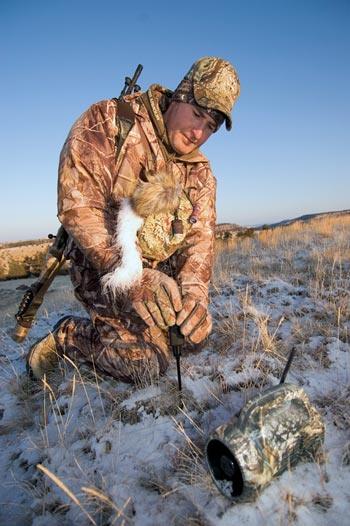
Josh Cluff sets his remote caller and a decoy about 30 yards upwind from where he will be hiding.
The 243 would still do the job in early autumn through October. South Dakota coyotes venture closer to game calls then because these predators aren’t hunted much during the hot summer months. Their guard is down.
However, the coyotes get wise fast when the weather cools enough for comfortable hunting. Coyote fanatics fill the air with distress calls, and deer hunters get into the mix, too.
“Deer hunters usually shoot at any coyote they see,” Cluff said. “And, many of them will do some coyote calling in the middle of the day when the deer hunting is slow.”
By the end of December, South Dakota’s coyotes are no longer eager dupes that lope into easy gun range. They approach with caution, hang up at 400 yards or more, and often tease you by sitting on their duff and yapping for several minutes. Then they do an about face and leave.
After being rejected in this fashion countless times, Cluff’s frustration was nearing the boiling point. The steam finally whistled out of his ears the winter day that a bobcat responded to his distress calls. It stopped on a hilltop 520 yards away and refused to come closer. Cluff wasn’t comfortable taking the shot with his 243, especially with the 15 to 20 mph crosswind.
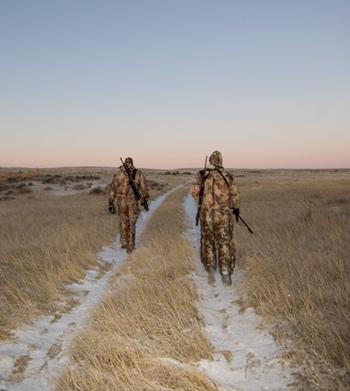
South Dakota’s Department of Game, Fish and Parks leases more than 900,000 acres of private land called Walk-In Areas. You may walk in and hunt Walk-In Areas, but you are not allowed to drive on them.
IT WAS TIME FOR ACTION:
THE WIND CHEATER
To reach out and touch coyotes beyond 400 yards, Cluff needed a heavier bullet with a higher ballistic coefficient than the 243 can deliver. He settled on the 6.5x284 Norma, an extremely accurate long-range round that’s used extensively in bench rest competition.
A 140-grain Berger VLD (very low drag) bullet is the business end of Cluff’s coyote round. He calls it a “wind cheater.”
“That long, narrow bullet really bucks the wind,” Cluff said. “It's also deadly on deer and antelope.”
Cluff went to H-S Precision in Rapid City, South Dakota, to have a rifle built that would take full advantage of the 6.5x284. He didn’t have to go out of his way because he is H-S Precision’s director of sales and marketing.
H-S Precision is among the leading producers of synthetic stocks. The company also builds high-end custom rifles. They guarantee that their rifles of 30 caliber and under will shoot 1/2-inch MOA at 100 yards. A target and load data are provided with each rifle.
Cluff had a heavy 26-inch fluted barrel fitted to an H-S action with an adjustable trigger, which he set at 2.5 pounds. A 2-inch muzzle brake at the end of the barrel reduces recoil by 65 percent. The action is anchored to an aluminum block, an integral part of the H-S Precision synthetic stock. The barrel is free floating.
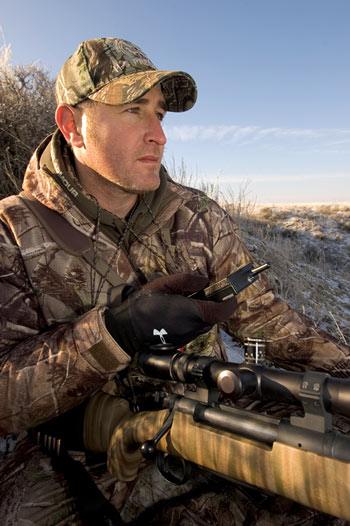
Josh Cluff relies mainly on a remote FOXPRO FX3 Digital Game Call. However, he also has rabbit distress calls on a lanyard around his neck so he can “mix things up.”
Talley bases and rings fix a Leupold VX-3 8.5-25x50 scope firmly atop the rifle. The scope features a Leupold custom-built turret that has been calibrated to Cluff's specific 6.5x284 load. The turret allows Cluff to dial in the exact yardage for the shot. The windage still must be doped. A Harris bipod ensures a solid rest.
An essential part of Cluff’s shooting gear is a 10x45 Zeiss Victory Rangefinder binocular. Cluff now feels confident taking 600-yard shots at coyotes.
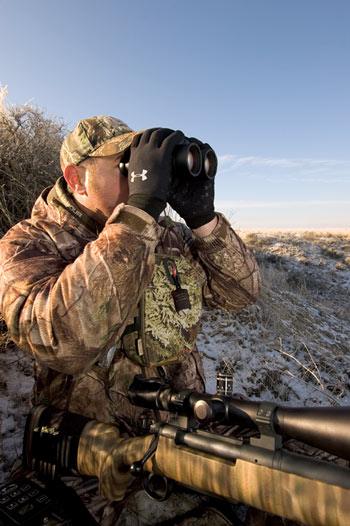
An essential part of Cluff's shooting gear is a 10x45 Zeiss Victory Range-finder binocular.
His longest kill with this rifle happened on a calm, early-morning hunt in South Dakota's Custer National Forest. Soon after Cluff began calling, a coyote showed itself on a high, distant bluff. It wasn’t convinced and took a seat to look things over.
At that distance, the coyote felt safe. It was in no hurry to leave. Cluff also was taking his time, because he hoped another coyote would show up and venture closer. Or, that he could lure in the wary coyote he had spotted. After 20 minutes of trying different calls with no results, Cluff ranged the dog at 625 yards and dialed the scope’s turret to that distance. He squeezed the trigger and watched with enormous satisfaction as the coyote crumpled.
PUBLIC LAND
Cluff hunts coyotes mainly on public land in western South Dakota, including the 600,000-acre Buffalo Gap National Grassland and approximately 78,000 acres of the 1.3 million-acre Custer National Forest that lie within South Dakota. The rest is in southeast Montana.
Both of these public areas have boundless, rolling prairies where you can see for miles, buttes, mesas and rugged draws. The ecologically diverse Custer National Forest also has an abundance of ponderosa pine.
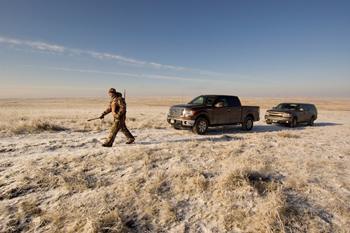
Two-track roads provide hunting access on many of South Dakota’s public hunting lands.
Although you are not allowed to drive over the prairie on these public lands, you can travel on two-track roads, many of which are marked with road signs. A 4-wheel drive vehicle with a high clearance is the recommended mode of transportation.
Since coyotes can be anywhere in these vast areas, the first challenge is how to get into position for a calling session without being seen. Never drive past an area before you hunt it, Cluff stresses. And, always park well back from a hill or lip of a cliff or a canyon so coyotes can’t see your vehicle. Then sneak into position, taking care not to skyline yourself. Always wear full camo and set up with a cliff, boulder, brush or some other cover behind you to break up your outline.
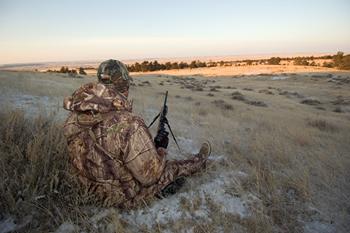
Josh Cluff at a typical calling setup. The crest of a hill is above him, sagebrush is behind him to break up his outline, and he is overlooking a draw that is likely to hold coyotes.
“The coyotes roam in the open prairie early in the morning and late in the evening,” Cluff said. “At midday, they’ll be in the draws and canyons.”
Cluff also hunts designated Walk-In Areas on private land. More than 900,000 acres of posted Walk-In Areas are leased for hunting by the South Dakota Department of Game, Fish and Parks. You may walk in and hunt Walk-In Areas, but you can’t drive on them.
To help him find Walk-In Areas and other public hunting lands, Cluff downloaded the South Dakota GPS mapping system from the South Dakota Department of Game, Fish and Parks Web site. (gfp.sd.gov/wildlife/gps/default.asp.)
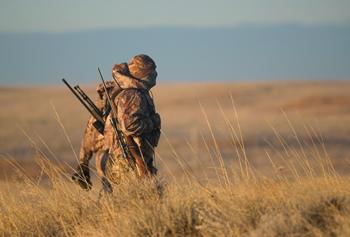
Long-range shots are the norm when hunting coyotes on South Dakota’s western prairies.
After he uploaded the program into his hand-held GPS, the screen displayed various types of public hunting areas. They are color-coded so you can tell which ones are State Forests, National Grasslands, Walk-In Areas, and so on.
“The program also keeps you from inadvertently trespassing because you can see right where you are on the GPS,” Cluff said.
CALLING STRATEGIES
Cluff generally sets up below the rim of a cliff or a hill where he can look over miles of rolling prairie or a canyon or draw. This allows him to see approaching coyotes long before they come within rifle range. He places his FOXPRO FX3 Digital Game Call 30 yards upwind of his position.
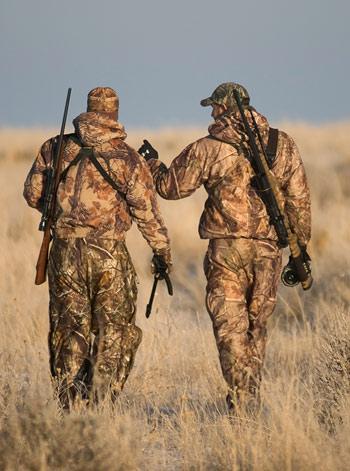
“Hunter-wise coyotes will try to circle downwind 90 percent of the time,” Cluff said. “You have to nail them before they get far enough to wind you.”
Cluff’s remote electronic caller emits dozens of different sounds, including the cottontail and jackrabbit distress calls that most hunters rely on. Cluff uses rabbit distress calls, but he often fares better with something different, such as woodpecker in distress, starling in distress and coyote pup in distress.
Whatever call Cluff chooses to send across the prairie, he always avoids a rhythmic cadence. This is a common mistake, he believes. For example, if you repeatedly call for 10 seconds and then pause for 10 seconds, the regular cadence sounds unnatural no matter how realistic the tone. It could prompt a hunter-wise coyote to skedaddle.
Constantly change the length of your calling sequences and your pauses, Cluff advises. An irregular pattern better mimics what happens in the natural world.
“I can see a long way with my binocular in prairie country,” Cluff said. “If a coyote doesn’t show in 20 minutes, I’m outta there.”
When Cluff spots a distant coyote that’s lukewarm to his calling, he studies it through his binocular while trying different calls. Sometimes a coyote is more interested in mousing than responding to any call, and it eventually loses interest.
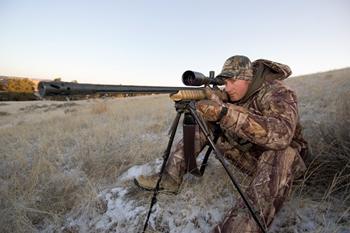
Then again, Cluff often comes up with something that pulls the coyote within range. That something might be as simple as letting the electric call run continuously at a higher volume. Or, you might need to try several different calls until one grabs the coyote’s attention. There is no set rule.
Switching calls did the trick when Cluff was hunting public grasslands near Pierre, South Dakota, during the month of February. He spotted a female coyote at 1,000 yards. She was curious about Cluff’s woodpecker in distress call, but wasn’t closing the distance.
“Then I tried the coyote pup in distress call and she came in on a beeline,” Cluff said. “I killed her at 25 steps.”
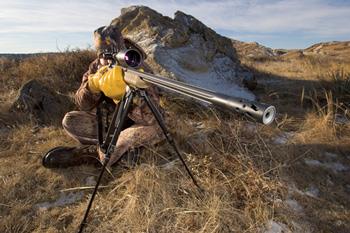 With his tricked-out H-S Precision rifle in 6.5x284 Norma, Josh Cluff feels confident taking shots at coyotes out to 600 yards or more. If you can overlook the yellow gloves, this photo nicely shows off the rifle’s fluted barrel and muzzle brake.
With his tricked-out H-S Precision rifle in 6.5x284 Norma, Josh Cluff feels confident taking shots at coyotes out to 600 yards or more. If you can overlook the yellow gloves, this photo nicely shows off the rifle’s fluted barrel and muzzle brake.
Cluff also has a few rabbit in distress calls on a lanyard around his neck. He prefers the electronic call because of its louder volume. But, there are times when mixing in a mouth call makes good things happen.
On a typical South Dakota public land hunt, Cluff sees five or six coyotes and bags one or two. He has taken as many as six coyotes in one day. The best late season hunting happens on miserably cold winter days. A wind prevents the coyotes from pinpointing your calling location, Cluff adds.
“Give me 10 below zero and a 5 mph wind,” Cluff says. “The coyotes have to eat more when it gets that cold. They’re hungry and likely to come charging in.”
By Mark Hicks
©Copyright The Varmint Hunters Association, Inc.
South Dakotan Josh Cluff is no longer content to hunt coyotes with his trusty H-S Precision SPL sporter chambered in 243 Winchester. Fitted with a Leupold VX-3 4.5-14x40 scope and loaded with 55-gr. Nosler Ballistic Tip bullet, the rifle is a coyote grim reaper out to 400 yards. Cluff’s problem with the 243 is call-shy prairie coyotes that hang up out of gun range.

Josh Cluff sets his remote caller and a decoy about 30 yards upwind from where he will be hiding.
The 243 would still do the job in early autumn through October. South Dakota coyotes venture closer to game calls then because these predators aren’t hunted much during the hot summer months. Their guard is down.
However, the coyotes get wise fast when the weather cools enough for comfortable hunting. Coyote fanatics fill the air with distress calls, and deer hunters get into the mix, too.
“Deer hunters usually shoot at any coyote they see,” Cluff said. “And, many of them will do some coyote calling in the middle of the day when the deer hunting is slow.”
By the end of December, South Dakota’s coyotes are no longer eager dupes that lope into easy gun range. They approach with caution, hang up at 400 yards or more, and often tease you by sitting on their duff and yapping for several minutes. Then they do an about face and leave.
After being rejected in this fashion countless times, Cluff’s frustration was nearing the boiling point. The steam finally whistled out of his ears the winter day that a bobcat responded to his distress calls. It stopped on a hilltop 520 yards away and refused to come closer. Cluff wasn’t comfortable taking the shot with his 243, especially with the 15 to 20 mph crosswind.

South Dakota’s Department of Game, Fish and Parks leases more than 900,000 acres of private land called Walk-In Areas. You may walk in and hunt Walk-In Areas, but you are not allowed to drive on them.
IT WAS TIME FOR ACTION:
THE WIND CHEATER
To reach out and touch coyotes beyond 400 yards, Cluff needed a heavier bullet with a higher ballistic coefficient than the 243 can deliver. He settled on the 6.5x284 Norma, an extremely accurate long-range round that’s used extensively in bench rest competition.
A 140-grain Berger VLD (very low drag) bullet is the business end of Cluff’s coyote round. He calls it a “wind cheater.”
“That long, narrow bullet really bucks the wind,” Cluff said. “It's also deadly on deer and antelope.”
Cluff went to H-S Precision in Rapid City, South Dakota, to have a rifle built that would take full advantage of the 6.5x284. He didn’t have to go out of his way because he is H-S Precision’s director of sales and marketing.
H-S Precision is among the leading producers of synthetic stocks. The company also builds high-end custom rifles. They guarantee that their rifles of 30 caliber and under will shoot 1/2-inch MOA at 100 yards. A target and load data are provided with each rifle.
Cluff had a heavy 26-inch fluted barrel fitted to an H-S action with an adjustable trigger, which he set at 2.5 pounds. A 2-inch muzzle brake at the end of the barrel reduces recoil by 65 percent. The action is anchored to an aluminum block, an integral part of the H-S Precision synthetic stock. The barrel is free floating.

Josh Cluff relies mainly on a remote FOXPRO FX3 Digital Game Call. However, he also has rabbit distress calls on a lanyard around his neck so he can “mix things up.”
Talley bases and rings fix a Leupold VX-3 8.5-25x50 scope firmly atop the rifle. The scope features a Leupold custom-built turret that has been calibrated to Cluff's specific 6.5x284 load. The turret allows Cluff to dial in the exact yardage for the shot. The windage still must be doped. A Harris bipod ensures a solid rest.
An essential part of Cluff’s shooting gear is a 10x45 Zeiss Victory Rangefinder binocular. Cluff now feels confident taking 600-yard shots at coyotes.

An essential part of Cluff's shooting gear is a 10x45 Zeiss Victory Range-finder binocular.
His longest kill with this rifle happened on a calm, early-morning hunt in South Dakota's Custer National Forest. Soon after Cluff began calling, a coyote showed itself on a high, distant bluff. It wasn’t convinced and took a seat to look things over.
At that distance, the coyote felt safe. It was in no hurry to leave. Cluff also was taking his time, because he hoped another coyote would show up and venture closer. Or, that he could lure in the wary coyote he had spotted. After 20 minutes of trying different calls with no results, Cluff ranged the dog at 625 yards and dialed the scope’s turret to that distance. He squeezed the trigger and watched with enormous satisfaction as the coyote crumpled.
PUBLIC LAND
Cluff hunts coyotes mainly on public land in western South Dakota, including the 600,000-acre Buffalo Gap National Grassland and approximately 78,000 acres of the 1.3 million-acre Custer National Forest that lie within South Dakota. The rest is in southeast Montana.
Both of these public areas have boundless, rolling prairies where you can see for miles, buttes, mesas and rugged draws. The ecologically diverse Custer National Forest also has an abundance of ponderosa pine.

Two-track roads provide hunting access on many of South Dakota’s public hunting lands.
Although you are not allowed to drive over the prairie on these public lands, you can travel on two-track roads, many of which are marked with road signs. A 4-wheel drive vehicle with a high clearance is the recommended mode of transportation.
Since coyotes can be anywhere in these vast areas, the first challenge is how to get into position for a calling session without being seen. Never drive past an area before you hunt it, Cluff stresses. And, always park well back from a hill or lip of a cliff or a canyon so coyotes can’t see your vehicle. Then sneak into position, taking care not to skyline yourself. Always wear full camo and set up with a cliff, boulder, brush or some other cover behind you to break up your outline.

Josh Cluff at a typical calling setup. The crest of a hill is above him, sagebrush is behind him to break up his outline, and he is overlooking a draw that is likely to hold coyotes.
“The coyotes roam in the open prairie early in the morning and late in the evening,” Cluff said. “At midday, they’ll be in the draws and canyons.”
Cluff also hunts designated Walk-In Areas on private land. More than 900,000 acres of posted Walk-In Areas are leased for hunting by the South Dakota Department of Game, Fish and Parks. You may walk in and hunt Walk-In Areas, but you can’t drive on them.
To help him find Walk-In Areas and other public hunting lands, Cluff downloaded the South Dakota GPS mapping system from the South Dakota Department of Game, Fish and Parks Web site. (gfp.sd.gov/wildlife/gps/default.asp.)

Long-range shots are the norm when hunting coyotes on South Dakota’s western prairies.
After he uploaded the program into his hand-held GPS, the screen displayed various types of public hunting areas. They are color-coded so you can tell which ones are State Forests, National Grasslands, Walk-In Areas, and so on.
“The program also keeps you from inadvertently trespassing because you can see right where you are on the GPS,” Cluff said.
CALLING STRATEGIES
Cluff generally sets up below the rim of a cliff or a hill where he can look over miles of rolling prairie or a canyon or draw. This allows him to see approaching coyotes long before they come within rifle range. He places his FOXPRO FX3 Digital Game Call 30 yards upwind of his position.

“Hunter-wise coyotes will try to circle downwind 90 percent of the time,” Cluff said. “You have to nail them before they get far enough to wind you.”
Cluff’s remote electronic caller emits dozens of different sounds, including the cottontail and jackrabbit distress calls that most hunters rely on. Cluff uses rabbit distress calls, but he often fares better with something different, such as woodpecker in distress, starling in distress and coyote pup in distress.
Whatever call Cluff chooses to send across the prairie, he always avoids a rhythmic cadence. This is a common mistake, he believes. For example, if you repeatedly call for 10 seconds and then pause for 10 seconds, the regular cadence sounds unnatural no matter how realistic the tone. It could prompt a hunter-wise coyote to skedaddle.
Constantly change the length of your calling sequences and your pauses, Cluff advises. An irregular pattern better mimics what happens in the natural world.
“I can see a long way with my binocular in prairie country,” Cluff said. “If a coyote doesn’t show in 20 minutes, I’m outta there.”
When Cluff spots a distant coyote that’s lukewarm to his calling, he studies it through his binocular while trying different calls. Sometimes a coyote is more interested in mousing than responding to any call, and it eventually loses interest.

Then again, Cluff often comes up with something that pulls the coyote within range. That something might be as simple as letting the electric call run continuously at a higher volume. Or, you might need to try several different calls until one grabs the coyote’s attention. There is no set rule.
Switching calls did the trick when Cluff was hunting public grasslands near Pierre, South Dakota, during the month of February. He spotted a female coyote at 1,000 yards. She was curious about Cluff’s woodpecker in distress call, but wasn’t closing the distance.
“Then I tried the coyote pup in distress call and she came in on a beeline,” Cluff said. “I killed her at 25 steps.”

Cluff also has a few rabbit in distress calls on a lanyard around his neck. He prefers the electronic call because of its louder volume. But, there are times when mixing in a mouth call makes good things happen.
On a typical South Dakota public land hunt, Cluff sees five or six coyotes and bags one or two. He has taken as many as six coyotes in one day. The best late season hunting happens on miserably cold winter days. A wind prevents the coyotes from pinpointing your calling location, Cluff adds.
“Give me 10 below zero and a 5 mph wind,” Cluff says. “The coyotes have to eat more when it gets that cold. They’re hungry and likely to come charging in.”

